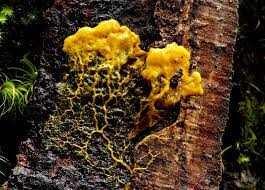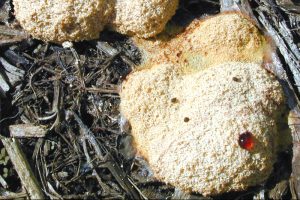A Survey of Invertebrates and Fungi
This week the In-Person Lab and Make Up Module are the same. If you miss lab, contact your TA ASAP to discuss how to complete the In-Lab and Post-Lab work on your own.
- Learning about fungi and invertebrates.
- Read the Lab Manual Lab Unit 7 and focus on the important Characters explained for Fungi (pages 116-118) for Invertebrates (pages 121-124).
- Review the Supplemental Information on Fungal and Invertebrates Groups below.
- Answer the questions found within the Pre-Lab assignment template.
- Example of a Dichotomous key: What kind of tree do you have? – Grab some deciduous or coniferous leaves still attached to 6-12″ of branches from a tree outside. Take a picture to include with your Pre-Lab. Test your dichotomous key abilities! Record each of your answer choices leading up to name identification (or at least as far as you can go). In the late Fall or Spring, you may have a hard time finding trees with leaves. You may try using this Winter Tree Identification key (even though not strictly dichotomous choices) if your tree does not have leaves yet.
- Write your reflection about one of the Fungal Video Clips below.
Supplemental Information on Fungal and Invertebrate Groups:
Fungi
Fungi play a very important role in the world. They can be useful ecologically by forming mychorrhizae associations with plant roots, decomposing dead plant and animal matter, and stabilizing sewage. Fungi are usually classified as molds, mildews, yeasts, mushrooms and puffballs. They are known as a group of organisms that are lacking in chlorophyll, are usually non-mobile, filamentous and multicellular, and have chiton in their cell walls.
Introduction to the Fungi (also click on other links within for Life History and Ecology) – Use Safari or Firefox for this link to see images and the needed Life History and Ecology links. They do not seem to show well in Chrome.
Comparing these Fungal Life Cycles for the Zygomycota, Ascomycota, Basidiomycota and fungal related groups Lichen and Slime Molds will help you fill out Table 7-1 on page 118. These groups are separated based upon their hyphae, reproductive structures and life cycles.
Zygomycete Life Cycle(Black Bread Mold – Rhizopus stolonifer)
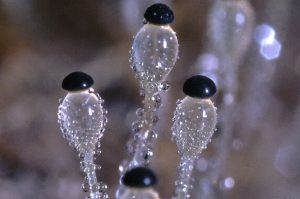
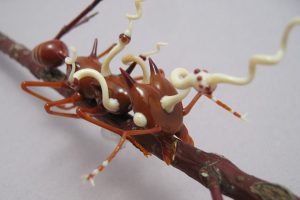 .
.
Fungal Associated Groups
(often studied with fungi, but not true fungi)
Lichens
Slime Molds –
- What is a Slime Mold?
- “Fungus” of the Month – good background information
Fungal Video Clips: time lapse photography can help us see just how cool fungi are!!!
- Stalking the Wild Mushroom (nice background on groups) (5:24)
- Basidiomycete growth and spore release (1:33)
- The Fastest Living Thing on the Planet (5:00) – Pilobolous! a Zygomycete that grows on poop!
- Slime molds on the Move (4:02)
- Attack of the Killer Fungi (3:04) – Cordyceps (fungi) attack insects.
Invertebrate Animals
Click on each Phyla below to help you with the Invert part of the Webquest. You may need to click on links within each of these linked pages. There are also good links within the Webquest to help answer questions.
| Phyla and Basic Characteristics | |
| Annelida Arthopoda Cnidaria Echinodermata Mollusca Nematoda Platyhelminthes Porifera |  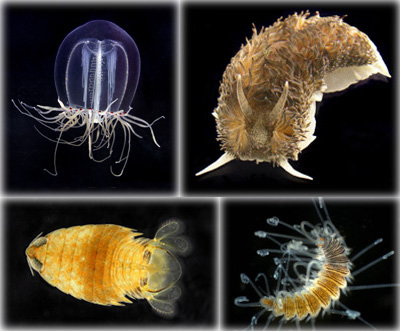 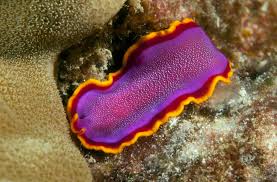 |
Dichotomous Keys:
Working with your group:
- In the Phylogeny lab we grouped organisms together based on similarities. This week we’ll group and identify organisms based on how they differ. In this lab we will use dichotomous keys to separate organisms into groups based on their differences.
- Activity One: Practice Key Construction (p. 115 in the lab manual) will help you better understand how to use a dichotomous key. Groups will share results.
- Fill in Table 7-1 in your lab manual as you visit each of the Fungal Group demonstration areas around the lab room. Discuss your answers with your table mates and come to a consensus for each of the Fungal Characters in Table 7-1. Complete the provided template in the Google Drive lab folder from your TA with your group’s completed Table 7-1.
- Proceed to the Invertebrate groups, and come to a consensus for each of the Characters listed on Table 7-3. Fill in Table 7-3 in your lab manual AND as a group in the provided template in your class Google Folder.
- Using Dichotomous Keys: Unknown Invertebrates. Watch videoclips of invertebrate organisms and use the key below to place each one in the correct group. As a group, you will be assigned 2 videos to watch and determine their appropriate Invertebrate phyla. Groups will then present their videos, and provide an explanation of why that group was chosen using the Invertebrate Key to point out the key features of those groups.
- At the end of lab, your group will upload all of the work completed in the provided template to Moodle.
This week only, the Lab 7 Post-Lab will be due at the start of Lab 8 (Species Relationship), Nov. 7-11 to give you more time to complete the Webquest and Scavenger Hunt.
***Post-Lab Assignment Summary (see the Post-Lab Handout for completing all tasks summarized below):
- Scavenger Hunt Collection: Find 1 example for each of the Fungal and Invertebrate phyla listed in the lab unit. Like the Phylogeny lab scavenger hunt, these should be pictures you take from nature (outdoors) and/or indoors, pet/aquarium stores, grocery stores…. but should not be pictures you have taken off the web, not even our lab website. Pictures from the web will not count unless they are from our Vr Ecosystems (see below). Some phyla may be hard to find.
- Are you unable to go outside? Go on a virtual field trip to visit virtual reality (VR) ecosystems. Find as many organisms as you can and take screen shots of what you find. Make sure you cite which of the VR Ecosystems the screenshot came from and include the “node” or the location of the organism within the ecosystem. Then Follow the rest of the assignment instructions. If using screen shots from from these VR ecosystems, be sure to label each screen shot with the Ecosystem name and the “node” or location where the organism was found.
- Include your pictures in the template provided in the Post-Lab Handout. Be sure to include your rationale including key characters from the Fungal or Invertebrate Keys that are found within these groups that led you to the group identification.
- Use Fungal and Invertebrate keys to help you ID the Group names for your own organisms. Provide the chosen steps/pathway with each of your pictures.
- Finalize and submit the Fungal and Invertebrate Webquest Assignment linked in the yellow assignment box below will demonstrate your understanding of these Fungal and Invertebrate groups.
- The background material in the Lab Manual, your completed Tables 7-1 and 7-3, the Supplemental Information, and demo observations you will see in lab this week will help you complete the Webquest.
- Continue working on your Ecology Lab Report (due next week Nov. 7-11) and/or your Experimental Design Project (Progress Report due Nov. 14-18).
Fungal and Invertebrate Webquest
Use the links within the webquest and on this webpage to complete this assignment. This will demonstrate your understanding of these groups and representative group members. This assignment is due at the start of Lab 8: Species Relationship lab (Apr. 3-7).
14 Fun Facts about Marine Bristle Worms (Polychaete Worms = a class of Annelida)
- check out the video of the 10 foot long Bobbit worm vs. Lion Fish at fact #9 (warning this does not end well)
Beautiful pictures and a short article on Echinoderm tube feet and papulae
Graceful swimming crinoid (feather star)
Never Seen Before Colony of 1,000 Brooding Octopuses Found off the Californian Coast
Sea sponges launch slow motion snot rockets to clean their pores – open the article to see the embedded slow motion videos.
Cancer-like Slime Mold Growth Hints at Multicellularity – Interesting article on the possible origin of Slime Molds and multicellularity in Plants, Fungi and Animals.
Discover Life – learn to identify organisms
Seek by iNaturalist – app that helps you identify organisms: (plants, animals including insects, fungi)


